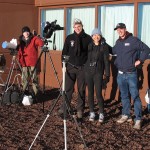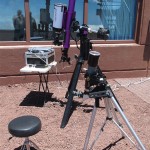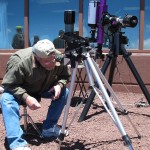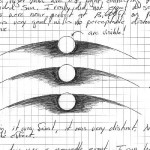We did the Transit of Venus right.
The plan was to stream the transit live from the summit. With access to the Keck facilities we had internet, a comfortable break room, and an excellent vantage point from which to view the entire transit. It sounded so easy at first, just put a camera on a telescope and connect it to the computer for the duration. Easy, in concept. The reality? Not so much.
It was an incredible amount of work. I had spent several days during the preceding weeks preparing the gear for transit. I admit some of that was fun, an excuse to get the gear out in the day and look at the Sun, even photograph Venus quite near the Sun.
The webcast team consisted of three people, Larry O’Hanlon, the Keck PIO, Mark Senft, a volunteer from our astronomy club, and myself. Larry and I met a HQ to begin our drive up the mountain at 8am.
At Hale Pohaku we picked up Mark and enjoyed breakfast. Here we found a massive buildup in progress, a gathering of troops… Visitor center staff, Hawai’i County police and fire, and the Mauna Kea Rangers, all present in force. Stephanie Nagata, the director of the Office of Mauna Kea Management helped man the roadblock. Stewart Hunter, the head of Mauna Kea Support Services with her in an orange vest. Their preparations looked to be necessary, three hours prior to first contact the crowds of transit tourists were already growing.
We arrived at the summit just over two hours prior to first contact to begin the setup of the gear we had brought. The gear consisted of the 90mm APO refractor and the AT6RC, an Astro-Tech 6″ Ritchey–Chrétien). Both of these ‘scopes would carry cameras.
The 90mm APO would be the webcast telescope, with a glass solar filter the solar image would be a recognizable yellow color. The AT6RC would be the photographic scope, a Baader film solar filter would provide a white solar image at slightly higher resolution for the photos, resolution that would be wasted on the web feed where the image was only 1024×768 in place of the full 18Mpx. That was the plan, it mostly worked.
I was going to use the observatory’s Canon 40D for the web feed. But at last moment I was having trouble getting the software to properly recognize it. With minutes to spare before first contact I swapped for my 60D that I had used for much of the testing. The price would be the need to change batteries partway through the webcast as I had no AC power adapter for the 60D. Twice it was necessary to run out with a freshly charged battery during the webcast.
The 40D was used on the photographic ‘scope, an 18Gb flash card allowed for the over 200 raw images needed to span the entire transit at two minute intervals. My other worry was the intervalometer used on the 40D, it had shown a low battery waning last time I used it. The 60D used a different intervalometer, which was ready with fresh batteries and never used after the camera swap. Fortunately the intervalometer battery held for seven hours, probably as the device was sitting in the bright sunlight and nicely warm, the heat giving a little boost to the battery.
For visual I had made another solar filter for my little TeleVue 76mm refractor. On a simple alt-az mount it would provide a ‘scope for the guys on the summit crew to look through. I could share the view and get a nice view of the transit for myself. I fully admit I hogged my telescope for the five minutes leading up to second contact. I was so glad I did as the view was incredible. I did not see the black drop as expected, instead I witnessed the far rarer aureole of Venus, a truly extraordinary view!
The three of us fell quickly into our roles… Larry would be the producer for this broadcast, I was the techie keeping the gear running, Mark was a roadie by his own description. There was no discussion of plans, we just did it, the everything getting done surprisingly smoothly. Larry was everywhere… On the phone coordinating interviews and outreach activity at both Keck locations. On the phone with UStream insuring we had bandwidth. Doing the things any producer has to do for a live production in progress.
Mark was just a volunteer along to help a bit, or so he said. His help that turned out to be invaluable, I could not have done it without him. Running cables, lugging gear, continually nudging the telescope to keep it on target, letting me know when something had inevitably gone awry. I just have to say… “Mohalo Mark!!”
I had not realized just how popular the transit would be. After all, this was not a total solar eclipse. I expected interest to mostly be from the amateur astronomy community, and much of the activity focused on Mauna Kea. Fortunately the planning put in place by out Keck staff allowed for more, a lot more.
I wasn’t long into the transit we heard that our Hualalai Auditorium in Waimea was packed, a room with a capacity for a couple hundred people. Worse, everyone was watching our web-stream! The online presence was even larger, the number of viewers climbing into the thousands. We were on the spot now, all effort focused on keeping the stream going. Keep the telescope on target, keep the information flowing.
I did have some material pre-prepared to show, and ended up using very little of it. Instead we did fan-service! The stream of comments and questions coming in on the UStream page and on FaceBook was stunning, a firehose blast of messages coming at us. I tried to read as much as I could, picking out great comments. There were viewers from all over the world, every continent accounted for, Antarctica included! When a good question popped up we could answer it on the air. Thus our feed became an interactive show, working with the audience to fill the hours of transit. Apparently this was quite the hit, many folks staying with us just for the multi-way conversation.
One worry we did have going in was weather, the Mauna Kea Weather Center forecast threatened summit level clouds and high winds. Both never materialized, there was wind, but it remained moderate. The clouds came up, but stayed just below our view for much of the event, with just a bit of interference at the end with the Sun and Venus low in the sky.
I had a good solar image on the stream with just a few minutes to spare. A nice orange disk sporting a nice arrangement of sunspots. We eagerly counted down the minutes to T hour.
I was amazed at how quickly after the appointed time Venus appeared, a little nibble out of the limb of the Sun. Somehow I had expected it to take longer to be truly noticeable. After all of the anticipation, the years of waiting, the event had begun.

One surprise was the group of half a dozen tourists that found shelter behind Keck’s walls. I really did not expect anyone to make it over to Keck this day. Private vehicles were denied access to the summit for the day. The free shuttle did not run anywhere near Keck, stopping only on the summit ridge. To reach us these folks had to walk the half mile from the ridge.
They realized that the same place I had setup would provide decent protection from the wind while giving a good view of the entire event. We shared views through each other’s telescopes and enjoyed the transit together. The open door to the Keck 1 control room was a warm bit of shelter from which they could watch our webcast.
The visitors were quite dedicated, staying for the entire six and a half hours. It was only when the transit ended that realization set in and it was apparent that they would have to walk back up to the summit to catch a ride back down A long walk at high altitude is potentially a problem, worse with darkness looming. Ron provided the answer, giving them a ride back to the shuttle stop in our vehicle, neatly averting a real danger with a little aloha.
About an hour into the webcast Larry started to get nervous. At this point the viewership was headed north of 5,000 viewers and he began calculating the amount of bandwidth our audience was consuming. Multiplying this by the length of the transit he was realizing we would not only consume the bandwidth he had purchased prior to transit, but run considerably over.
After two rounds of calculations with a steady ramp up in viewership, nervousness turned to panic. This was a far larger audience than we had ever encountered for one of the lectures, and the length was much longer than the usual hour long lecture as well. There was no way his budget would cover this!
A phone call to Debbie, our fundraising expert, resulted in one answer, an answer that Larry was not comfortable with… Ask for money. He reluctantly got on the air and made his pitch. To my utter amazement the audience responded! Donations poured into our website. At the end of the day almost $8000 had been donated, neatly covering our anticipated expenses with maybe a bit left over for next time.
The incident has given me a new appreciation for the value people place in what we do. It also underscored the need for us to give back to our community, and to invite the public at large into the observatory whenever the opportunity arises, even if only vicariously through the camera’s eye. We will be doing this again.
We were well into the long haul at this point. Knowing the numbers, the times of contact, the hours that it takes for Venus to cross the face of the Sun, is academic in the face of watching the planet crawl across the image. A bit over halfway through Venus passed by a nice group of sunspots. In the zoomed view you could just perceive the motion if you looked away for a few minutes and compared the view. Slowly, glacially, steadily, the planet neared the far side of the Sun from where it first appeared.
Along the way Larry had arranged a few interviews to do on the air. I really have no training for this and had not prepared. But somehow I did it, conducting interviews with an aplomb I had never managed before.
The treat was an interview with Andrea Ghez, one of the top astronomers in the United States. We had a great conversation on the air. It helps that Andrea is very good at public work, quite used to being in the spotlight. On top of that she is just nice.
It was not until later that I realized how long and how hard I had worked. I was grateful that the cafeteria at Hale Pohaku had been serving breakfast late and we had gotten a solid meal. During the next twelve hours I subsisted on nothing more than a can of Diet Coke, a slice of beef jerky and a single handful of potato chips. As the end neared I was still going strong, despite the many hours of frenetic activity. Sheer adrenaline, the excitement of the event, simple joy in the experience… Whatever kept me going, I was truly living in the moment.
At 5pm the summit day crew said goodby, headed for home, their job was done and the big telescopes ready. A little after six we greeted the night crew’s arrival, telescope operators just arriving for work, ready for a night of observing. Missing no opportunity I put Cindy in front of the camera, she would be the Keck 1 operator this night, it was her control room we were intruding upon.
We counted down the minutes to third contact, with Mark calling out the time remaining. It was while we were waiting for third contact that disaster struck, first the sound, then the video feeds died. It was a frantic scramble for about five minutes. I could see the messages from multiple sources that something had gone horribly wrong. After attempting fixes within the software I gave in and shut it all down, cutting the feed entirely and closing the software. When restarted the sound came back, each camera providing an image as I brought them back individually. Just hold out a little longer!
At the end an odd sense of melancholy took hold. As the last fragment of Venus slid off the Sun’s disk the realization set in that it was over, that what we were seeing would not be seen again for over a century. An event I had anticipated for years, spent so much effort preparing for, was done.
I can look back with satisfaction, we did the transit right. No regrets, some nice photos, and great memories.







great post! and thanks for your hard work!
Excellent write-up! I loved the use of “glacially.” It was like watching the minute hand on God’s clock. I’m sure the tourists appreciated the proximity to a rest room. Congratulations, well done.
John
Good Job!! I saw your 3 rd and 4 th contact. Will you archive the footage somewhere for us to see that were to busy at the scopes?
Thanks
Aloha
Really loved to watch the transit online with you guys. Stayed up all night for that (Belgium).
Respect!
Thank you all for your hard work and dedication. I signed on t minus 10 min and stayed until you guys went off the air. I enjoyed myself the entire time. I know for a fact that a lot of people learned tons during this broadcast. My wish, hope and dream is that you continue to do events like this. You all gave it such a warm (beep) behind the scenes feel that made us all feel “part of the science.” The picture in picture was awesome and the graphics support mid-show was much appreciated.
I can’t wait until next time!
-E
Great report, and great effort, Andrew! Thanks for sharing it with us.
Jeremy
i spent 6 and change hours with you guys and I really appreciated your dedication to keeping everything up and running for us all around the world. HATS OFF YOU YOU ALL!
Our observatory in Sonoma County was clouded out much of the day so we had your feed up for our 300+ visitors to supplement live viewing between the clouds. After sunset I went home to watch the rest of the transit on Ustream and read the firehose of comments. It was a giant star party! Thanks for all the effort. Best outreach ever!
Thank you for all your hard work and for keeping everything rolling; this was the first time I have linked into this kind of site and started watcing just prior to the first nibble at the edge of the Sun as Venus appeared and for a while after that, it was amazing. Posted up link on FB too. Great to see at least part of an event which will not be repeated for approx 105 years! Cheers Guys! (N. Yorks UK)